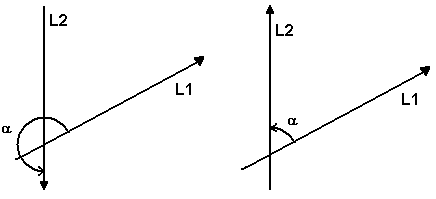Calculate the angles between two lines, two planes, two vectors, or a plane and vector.
- From
, select one of the following:
- Angle: Line to Line
- Angle: Plane to Plane
- Angle: Vector to Vector
- Angle: Plane to Vector
- Specify values for the options that follow. These options apply to all angle types.
See Dimension dialog options reference for definitions of general options used in multiple dialogs.
- Name
- Use nominals
- Visible
- Output in report
- Angle — To compare the measured angle with its nominal, select Use nominals, then enter the nominal angle between the reference items and the angle tolerances.
Click
 to report the reflex angle between the reference items. The button changes to
to report the reflex angle between the reference items. The button changes to
 .
.
Click
 to report the inner angle between the reference items. The button changes to
to report the inner angle between the reference items. The button changes to
 .
.
- Specify additional options for the type of angle you are dimensioning.
- Line to line angles
- Simple measures behavior
- Hide sign information
- Reference plane — Select the plane on which the lines are projected and on which the angle is calculated. The vector of the reference plane determines the positive direction of the calculated angle.
- Reference line 1 and
Reference line 2 — Select the lines that form the angle you want to measure.
The angle is measured from line 1 to line 2 using the parts of the lines nearest their direction arrows. To change the angle reported, use the Invert vector
 button to change the direction of the line vectors, as was done in this example:
button to change the direction of the line vectors, as was done in this example:

- Plane to plane angles
- Reference plane 1 and Reference plane 2 — Select the planes that form the angle you want to measure.
- Vector to vector angles
- Reference vector 1 and Reference vector 2 — Select the vectors that form the angle you want to measure.
Note: Angle: Vector to Vector differs from Angle: Line to Line in that Angle: Vector to Vector calculates the three-dimensional angle between the reference items and does not require a reference plane. - Plane to vector angles
- Simple measures behavior
- Hide sign information
- Reference plane and Reference vector — Select the plane and vector that form the angle you want to measure.
- Line to line angles